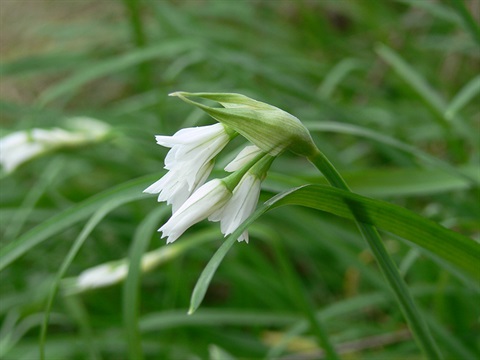Angled Onion

Allium triquetrum
Declared Noxious Weed
Origin: Mediterranean region
Size: 30 cm - 50cm H, 30cm W
Seeds: March to May
Flowers: August to November
Fruits: September to November
What it does
Angled Onion thrives in damp semi-shaded areas along stream banks, roadsides, bushlands and gardens. It can tolerate windy conditions. The leaves and stems have a strong onion-like smell when crushed.
These plants are known to smother and displace indigenous grasses and groundcovers preventing seed germination and bush regeneration.
Its presence is seasonal and it’s only visible from mid-winter to early summer, therefore, large infested areas can remain bare of vegetation for up to six months of the year, increasing chances of soil erosion.
It is known to impart a strong onion flavour and odour to dairy products and meats when allowed to grow in grazing areas.
Angled Onion is a declared Noxious weed across Victoria as it has the potential to spread widely and cause serious economic loss to agriculture or have some detrimental effect upon people, animals, the environment or the local community.
How it spreads
- has a white bulb, which has many bulblets that form beside the main bulb during flowering time, developing in the soil ready to emerge next season.
- produces seeds which are easily transported by water, machinery (e.g. lawnmowers) and soil movement.
- via illegal dumping of garden wastes in bushlands, along roadsides and waterways.
- it’s occasionally (illegally) sold as a plant at fetes and club fundraisers. Buyer beware!
Removal
Remove by hand
This is only practical for small clumps of the weed. It is important to fork out all bulbs from beneath the soil. This is best done in early to late winter. Continuous and regular brush cutting will remove it as well, but this must be done before seeds are set.
Spray with herbicide
Use a registered product and ensure you check the label and follow instructions. The most effective time to spray is mid-winter to early-spring before or at the start of the flowering cycle. Ring the Department of Energy, Environment and Climate Action on 136 186 for full details.
Dig out
Dig out patches of angled onion using a garden fork. Remove soil from around the bulbs and put into bags for safe disposal. Follow up each year until area is clear. The most effective removal of Angled Onion is before, or as, flowers appear and when parent plant is exhausted.
Indigenous alternatives to plant
Many groundcover and lily alternatives indigenous to the Yarra Ranges region are available and would
make great substitutes for Angled Onion. Some alternatives include:
Swamp Daisy, Allitia cardiocarpa
Milkmaids, Burchardia umbellata
How to dispose of weeds
By disposing of environmental weeds correctly you can prevent re-infestation on your property and elsewhere.
- Landfill (Weed Wipeout Tip vouchers available for some species).
- Green waste bins ensure that weeds are not able to spread.
- Woody weed stems can be bundled for green collection twice per annum.
- Composting (excluding seed heads or species with vegetative reproduction, e.g. Wandering Trad).
- Burning in accordance with Council and the Country Fire Authority (CFA) prescribed burning periods and regulations.
- Recovery and transfer stations available for weed tipping are Healesville, Wesburn, Coldstream, Lysterfield and Montrose.
Using chemicals
Non-chemical treatment is often the most effective and safe option especially on smaller scale infestations.
Where chemical use is undertaken:
- Always follow the manufacturer’s guidelines when using chemicals.
- Wear protective clothing and eyewear.
- When purchasing your herbicide, always ask for a Materials Safety Data Sheet (MSDS) or refer to the manufacturer’s website for specific safety guidelines and information.
- Some herbicides will kill other plants and not just the target species.
- When used near waterways herbicides can be very poisonous to aquatic life.
- Use chemicals sparingly and be sure that you are using the right chemical and application technique.
- Ensure the weather conditions are suitable (e.g. minimal wind and no rain expected).
- Apply herbicides at the correct time during the plant’s growth cycle so you get the best results.